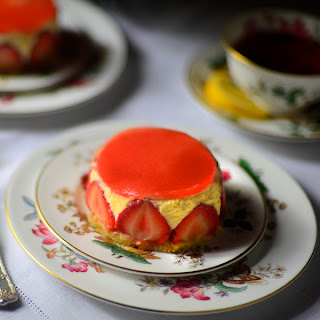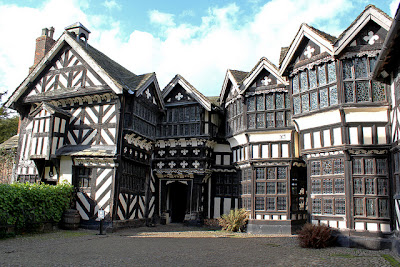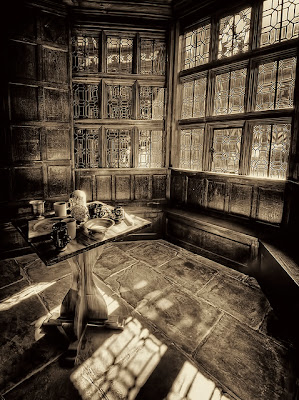It’s 5 Star Makeover time again and our theme this
month is an English tea party and all that goes with it.
When I heard tea party, my thoughts went
immediately to my platonic ideal of tea parties at Claridges in London and my
first elegant English tea. I’ve been to
wonderful tea parties since but that one remains the standard against which all
others are measured.
Oh yes, I did have a few small flirtations with tea
parties before Claridges –– first as a child purloining a precious miniature
golden set in my gram’s china cabinet for my make-believe tea parties and then as a teen with herbal teas
in rough artisanal mugs that went with patchouli oil, waist length hair and
folk music, but that was an aberration. The idea of taking tea was firmly
imprinted on my brain as an occasion perfumed with vases of blowsy roses, propped with elegant china, lots of
silver, tiered sweet stands and snowy
napery –– nearly blinding in its crisp whiteness. That was what I found manifestly at Claridges
in Mayfair. History and elegance is the
blood and breath and pulse of the place as is the sublime service.
I got to stay at the storied Claridges when I was just at the end of college and a lovely
friend swept me away to London after I told him I
loved the city –– 2 weeks later I was there –– and what a there! It was the perfect place to experience my
first great tea.
Claridges began in 1812 as Mivarts Hotel. It was combined in 1854 with a hotel
belonging to Mr and Mrs Claridge and soon became THE hotel in London when the
Empress Eugenie stayed there and Queen Victoria came to call in 1860. It was so successful that it was purchased by the
owner of the Savoy Hotel and impresario of Gilbert and Sullivan fame –– Richard
D’Oyly Carte. He tore down the old space and created a
state-of-the-art hotel in 1898 with individual bathrooms and elevators. It was successful as well.
1930 version
The 1920’s saw a new Deco spirit in London and Basil Ionides was brought in to re-design the restaurant
and bring it into the modern age. Ionides was a great choice (he's known for his striking
work on the Deco masterpiece, the Savoy Theatre).
In 1929, Sir Edwin Lutyen’s former assistant, Oswald
Milne, designed a new main entrance and removed the old-fashioned carriage
drive in the front of the hotel. The
30’s saw a new Deco addition to the east of the old Victorian Claridges
building (there are great images of the 1930s Claridges on the Royal Institute of British Architects site).
Since then, Thierry Despont did a 1996 renovation on
the venerable hotel that sort of pales in comparison to the earlier versions in
my humble opinion (as the following photos show–– you can decide for yourself).
The Dining room (now a Gordon Ramsey restaurant)
The entrance hall (from Claridges website)
The entrance hall (from Claridges website)
Many celebrities have stayed there from Cary Grant
to Brad and Angelina as well as visiting royalty and aristocrats from all over
the world. There is a story that someone
called up asking for The King and the polite fellow answered, “Which one?” It
has been called an extension to Buckingham Palace because of its long
connection with the royal family. Although they would go to the ends of the
earth for a client (they made a room a piece of Yugoslavia for a day so a
prince could claim he was born in Yugoslavia), they were sticklers for
appearances and made Kate Hepburn come in the service entrance when she was
wearing trousers.
Lovely people of all sorts still meet at Claridges and
for $50 to $100 they can luxuriate in the ceremony of taking tea for an
afternoon and feel the world revolve just a little more slowly for them for a
few hours.
Claridges Foyer (from Claridge’s site)
Claridges Foyer (from Claridges website)
I had such a clear memory of the serene service of
the place, the small sandwiches and cakes, scones and glacéed fruit with jam
pots, cream pots and tea, lovely fragrant tea (and a bit of champagne if I
remember correctly). It is still great, and won The Tea Guild’s 2011 Top London Afternoon Tea award.
I used to be terribly fond of creamy desserts and I
remember one that I found particularly addicting –– a Fraisier. There was something
about the soaked cake, fluffy cream and strawberries with the remarkable red
gelée that was perfection –– waves of flavor and texture. Perfect for a tea, or anything else for that
matter.
I never make desserts like this so was a bit daunted
by the prospect. I didn’t have the proper ring molds and ended up using stacked
English muffin rings for the individual version! It was quite a process getting the jelly to
behave so I made another, back-up version in a cut glass bowl like a neat
trifle which was much easier to do. The recipe that I used from Daring Bakers
made the dessert in a whole cake form.
You can pick your favorite. Think of it as an apotheosis of strawberry shortcake –– it's that good,
This recipe makes a good deal of cake and I must say
that I usually think of Fraisiers
made with a flat sheet cake in very thin layers. The fluffy chiffon cake was tough to cut in
thin layers, but I found the lightness of the cake quite lovely and an improvement on the more stolid sheet cake. Many versions of the dessert are made with 2
layers of cake on top and bottom –– I liked one layer better. Some versions also have a layer of almond
paste instead of the gelée. I love the
gelée and the tart contrast it offers and adding a little bit of Aftelier rose essence to the mixture makes it really superb.
Also, the cream layer is really fine.
Terribly light and airy so that it sort of evanesces in your mouth as
you eat it (and the rose geranium is another great addition to an already great recipe). All and all, it was great
and really refreshed my memories of that first great tea so many years ago.
Although it takes a bit of time it's less complicated than it looks. You could make it in a snap if you bought your cake.
Although it takes a bit of time it's less complicated than it looks. You could make it in a snap if you bought your cake.
Basic
Chiffon Cake (for base):
1
cup + 2 tablespoons (270 ml) (5½ oz/155 gm) all-purpose flour
1
teaspoon (5 ml) (4 gm) baking powder
3/4
cups (180 ml) (6 oz /170 gm) sugar
1/2
teaspoon (2½ ml) (1½ gm) salt
1/4
cup (2 fl oz/60 ml) vegetable oil
3
large egg yolks
⅓ cup + 1 tablespoon (3.17 fl oz/95 ml) water
1
teaspoon (5 ml) pure vanilla extract
3/4
teaspoon (3¾ ml) (3 gm) lemon zest, grated
5
large egg whites
¼
teaspoon (1¼ ml) (1 gm) cream of tartar
Directions:
Preheat
the oven to moderate 325°F (160°C/gas mark 3).
Line
the bottom of an 8-inch (20 cm) spring form pan with parchment paper. Do not
grease the sides of the pan.
In
a large mixing bowl, stir together the flour and baking powder. Add in all but
3 tablespoons (45 ml.) of sugar, and all of the salt. Stir to combine.
In
a small bowl combine the oil, egg yolks, water, vanilla and lemon zest. Whisk
thoroughly.
Combine
with the dry ingredients and mix thoroughly for about one minute, or until very
smooth.
Put the
egg whites into a stand mixer, and beat on medium speed using a whisk
attachment on a medium speed, until frothy. Add cream of tartar and beat on a
medium speed until the whites hold soft peaks.
Slowly
add the remaining sugar and beat on a medium-high speed until the whites hold
firm and form shiny peaks.
Using
a grease free rubber spatula, scoop about ⅓ of the whites into the yolk mixture
and fold in gently. Gently fold in the remaining whites just until combined.
Pour
the batter into the prepared pan. Bake for 45 to 55 minutes or until toothpick
inserted into the center comes out clean.
Removed
the cake from the oven and allow to cool in the pan on a wire rack.
To
unmold, run a knife around the sides to loosen the cake from the pan and remove
the spring form sides. Invert the cake and peel off the parchment paper.
Refrigerate for up to four days.
Pastry
Cream Filling
1
cup (8 fl oz/250 ml) whole milk
1/2
teaspoon (2½ ml) pure vanilla extract
1/8
teaspoon (1/2 ml) (¼ gm) salt
2
tablespoons (30 ml) (10 gm) cornstarch
1/4
cup (60 ml) (2 oz/55 gm) sugar
1
large egg
3
large rose geranium leaves cut in large pieces (optional)
2
tablespoons (30 ml) (1 oz/30 gm) unsalted butter (optional)
3/4
teaspoon (3¾ ml) (4 gm) gelatin
1/2
tablespoon (7½ ml) water
1
cup (8 fl oz/250 ml) heavy cream
Directions:
Pour
the milk, vanilla, and salt into a heavy sauce pan. Place over medium-high heat
and scald, bringing it to a near boiling point. Stir occasionally.
Meanwhile,
in a stand mixer add the cornstarch and sugar. Whisk to combine
Add
the eggs to the sugar and cornstarch and whisk until smooth.
When
the milk is ready, gently and slowly while the stand mixer is whisking, pour
the heated milk down the side of the bowl into the egg mixture. Add the rose geranium now if you are using them
Pour
the mixture back into the warm pot and continue to cook over a medium heat
until the custard is thick, just about to boil and coats the back of a spoon. Take the leaves out at this point.
Remove
from heat and pass through a fine mesh sieve into a large mixing bowl. Allow to
cool for ten minutes stirring occasionally.
Cut
the butter into four pieces and whisk into the pastry cream a piece at a time
until smooth if you are using the butter. If you want a stronger rose geranium flavor, put the leaves back in the cream.
Cover
the cream with plastic wrap, pressing the plastic wrap onto the top of the
cream to prevent a skin from forming. Chill in the refrigerator for up to five
days. Remove the leaves when you are ready to move on to the next step.
In
a small dish, sprinkle the gelatin over the water and let stand for a few
minutes to soften.
Put
two inches (55 mm) of water into a small sauce pan and bring to a simmer over a
medium heat.
Measure
1/4 cup (2 oz/60 ml) of the chilled pastry cream into a small stainless steel
bowl that will sit across the saucepan with the simmering water, without
touching the water.
Heat
the cream until it is 120 F (48.8 C). Add the gelatin and whisk until smooth.
Remove from the water bath, and whisk the remaining cold pastry cream in to
incorporate in two batches.
In
a stand mixer, fitted with the whisk attachment, whip the cream until it holds
medium-stiff peaks. Immediately fold the whipped cream into the pastry cream
with a rubber spatula.
Simple
Syrup:
1/3
cup (2⅔ fl oz/80 ml) (2⅔ oz/75 gm) of sugar
1/3
cup (2⅔ fl oz/80 ml) of water
Directions:
Combine
the water and sugar in a medium saucepan.
Bring
the mixture to a boil and let the sugar dissolve. Stirring is not necessary,
but will not harm the syrup.
Remove
the syrup from the heat and cool slightly.
OR
warm a good currant or herb jelly and use it
OR
moisten the cake with a good madeira or sherry-spiked sugar syrup like a trifle
I’d say 2 T should do it.
Strawberry
Gelée (Adapted from Martha Stewart)
1
pound strawberries
1
0r 2 drops Aftelier rose essence or 2 t rose water (optional but if you use
the rosewater, then use less cold water)
½
c sugar
½
c plus 3 T cold water
¼
t coarse salt
1
T plus 1 t lemon juice
1
¾ t unflavored gelatin
Puree
the berries with sugar, ½ c water and salt.
Strain through a fine strainer (you should have 2 c). Sprinkle gelatin over water and soften for 5
minutes. Heat the strawberry puree over
medium heat. Add the gelatin to ½ c
puree and combine, then combine with the rest of the strawberries and the
rose. Let it cool somewhat before
pouring on the cream.
Assembly:
Components:
1 baked 8-inch (20 cm)
chiffon cake
1 recipe pastry cream
filling
⅓ cup (80 ml) simple syrup
2 lbs (900 g) strawberries
(this is generous)
1 recipe strawberry gelée
Directions:
.
Line the sides of a 8-inch
(20 cm) spring form pan or 6-8 single molds with plastic wrap. Do not line the
bottom of the pan/molds.
.
Cut the cake horizontally to
form thin layers. I made mine quite thin but you can chose the best for your
taste.
.
Fit the bottom layer into
the prepared spring form pan or molds. Moisten the layer evenly with the simple
syrup. When the cake has absorbed enough syrup to resemble a squishy sponge,
you have enough.
.
Hull and slice in half
enough strawberries to arrange around the sides of the cake pan. Place the cut
side of the strawberry against the sides of whatever pan you use, point side up
forming a ring.
.
Pipe cream in-between
strawberries and a thin layer across the top of the cake (I also used the end
of a spoon to make sure the cream had gone between the berries).
.
Hull and quarter your
remaining strawberries and place them in the middle of the cake. Cover the strawberries
and entirely with the pastry cream.
.
Pour the just cooled gelée
on top in an even layer and refrigerate for at least 4 hours.
.
To serve, release the sides
of the spring form pan and peel away the plastic wrap or pull off your rings
and peel away the plastic or just serve if you are putting it in a glass bowl.
Serve immediately or store in
the refrigerator for up to 3 days
Most of the information about Claridges came from their website.
Most of the information about Claridges came from their website.
hosted by 5 Star Foodie & Lazaro Cooks!
Come visit the five star makeover on Friday to see all the great tea parties from my amazing compatriots!
Thanks to Gollum for hosting Foodie Friday!

































